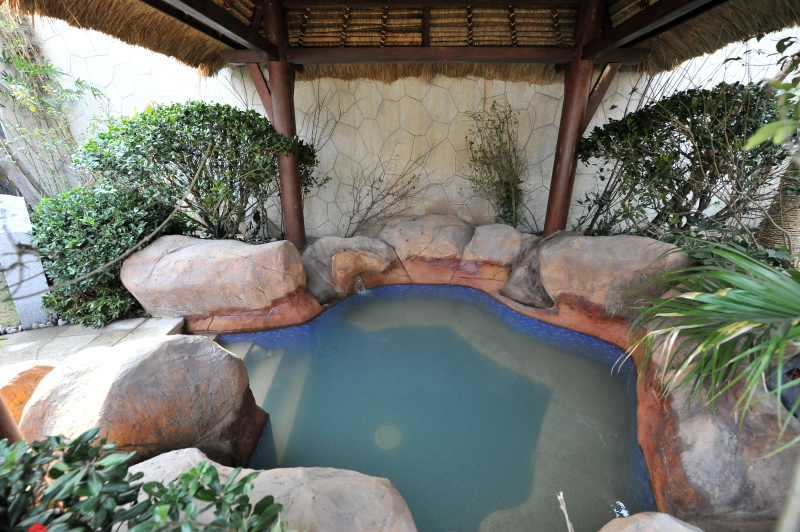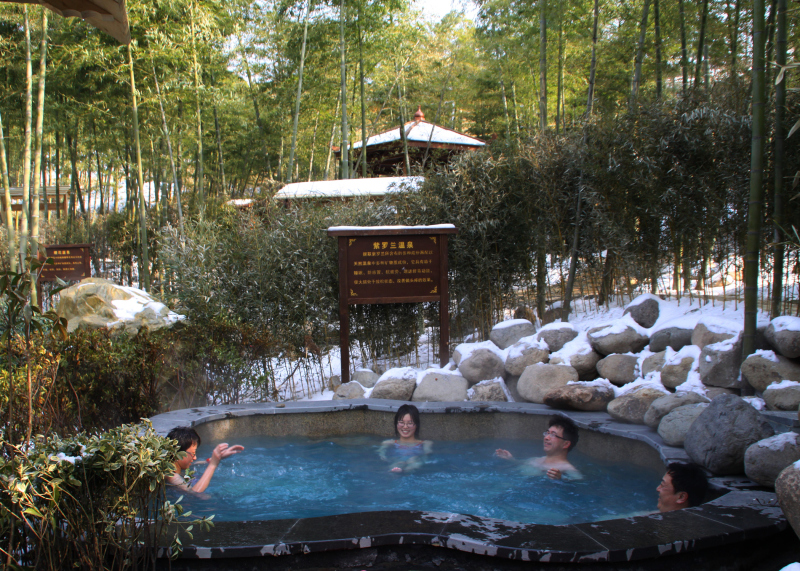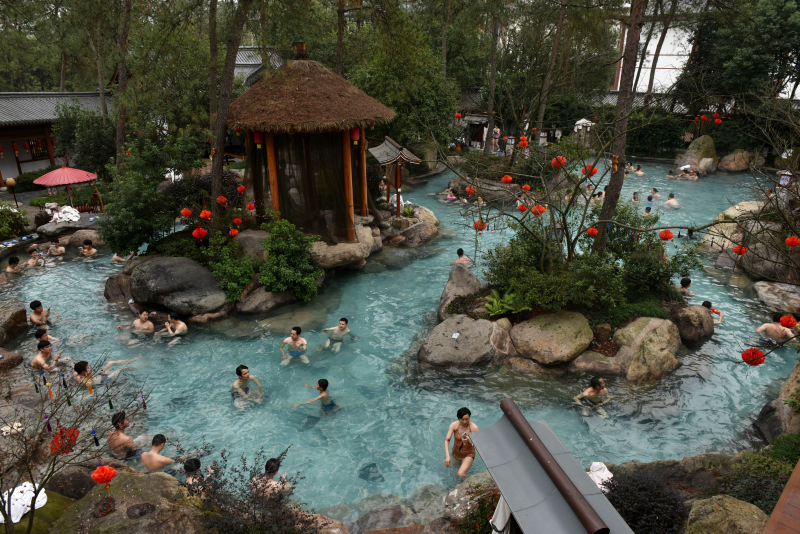除了大大的太阳,温泉是冬天里最温暖的治愈,也是旅游线路上重要的一站。在热腾腾的温泉里泡着,肯定是很多泡汤爱好者最想要的度过冬天的一种方式。
一
“春寒赐浴华清池,温泉水滑洗凝脂。”
读过唐诗宋词的,无人不知此诗出自白居易代表作《长恨歌》。唐宪宗元和元年(公元806年),白居易任盩厔(今西安市周至县)县尉。一日,他与友人陈鸿、王质夫到马嵬驿附近的仙游寺游览,谈及李隆基与杨贵妃事。王质夫认为,像这样突出的事情,如无大手笔加工润色,就会随着时间的推移而消失。他鼓励白居易:“乐天深于诗、多于情者也,试为歌之,何如?”于是,白居易写下了这首千古绝唱《长恨歌》。
这是温泉出现在古代名诗里较为典型的例子。而华清池所在的西安骊山,景色秀丽,相传周幽王在此建骊宫,秦始皇时改为“骊山汤”,汉武帝时扩建为离宫,唐太宗营建宫殿取名“汤泉宫”,唐玄宗再次扩建后取名华清宫,因以温泉为特征,又称华清池。上古时期,女娲在这里“炼石补天”;西周末年,周幽王在此上演了“烽火戏诸侯”;秦始皇将他的陵寝建在骊山脚下,留下了闻名世界的秦兵马俑军阵;盛唐时,唐玄宗与杨贵妃在此演绎了一场凄美的爱情故事;现代史上,著名的“西安事变”也发生于骊山之上。
其实浙江的温泉也不少,安吉、宁海、泰顺、武义等地都有。
一处温泉,赋予如此厚重的文化与政治含义的,环顾四海也不多见。不过,随着世事变迁、沧海桑田,更多的温泉,只是作为大自然的馈赠,以一条河流的姿态,温暖地流淌在人们的生活里了。由于温泉是一种含有对人体健康有益的微量元素的矿物质泉水,所以,人们习惯把泡温泉当作冬季健康养生的重要选择。这种习惯,从秦始皇时代就开始了,据说,他建“骊山汤”就是为了治疗疮伤。《水经注》也提到温泉可治病,如“鲁山皇女汤,可以熟米,饮之愈百病,道士清身沐浴,一日三次,四十日后,身中百病愈”。唐太宗晚年所著《汤泉赋》则称:“每濯患于斯源,不移时而获损”。

二
很多年以前,我第一次抵达宁海的深甽镇,那儿的森林温泉,也称天明山南溪温泉,是中国较为著名的温泉。在我的记忆里,宁海森林温泉地处某山坳,与后来扩建的建筑与景观相比,当时的房子显得要简陋一些。我们入住的平房里就有温泉。与普通的水质不同,温泉在皮肤上滑过,会出现晶莹的水滴状,如果从水里起身,也不似普通的热水急速下淌,而是以相对缓慢的速度下滑。我们都说,这才是真正的温泉。室外有池,从地底下喷涌而出的泉水,冒出白色的蒸汽,在冬季寒冷的天空下,显得十分温暖。
我问接待我们的工作人员,这处温泉是什么时候发现的。她说具体时间不详,只知道1960年就开始开发了,有华东第一森林温泉之誉。她指着我们住的平房,说这批房子应该就是那时候留下的。
宁海籍著名画家潘天寿曾经到过这里,还留下过一首诗:“踪迹十年未有闲,喜今便得故乡还。温泉新水宜清浴,爱看秋花艳满山。”
黄昏时分,我沿着温泉周边散步,有一条小道,通向山坳。越往里走,越寂静,只听见鸟鸣和风吹动树叶的声音。天色也似乎要比平原沉得早,这显然跟两侧起伏的山峦有关。我回头张望,可见温泉大池上空,有缭绕的水蒸气,恍若白云在空中盘旋。
三
浙江山多,历史上就有“七山一水二分田”之说。山多,温泉也多。除了宁海森林温泉,我还先后去过临安的湍口温泉、泰顺大峡谷温泉和武义温泉。我发现,这些温泉大多有一个共同点,就是它们所处的地理位置,基本上都是山区,或者是山坳,或者是峡谷。这显然与温泉形成的地理特征有关。
通常,温泉的形成有两种原理。
因地壳内部的岩浆作用,或受火山喷发所影响,这些因地壳板块运动而隆起的地表,其地底下还有未冷却的岩浆,会不断释放出大量的热能。
如果此类热源之热量集中,附近有孔隙的含水岩层,不仅会受热成为高温的热水,而且大部份会沸腾为蒸汽,产生温泉。
第二种是由地表水渗透循环作用所形成。也就是说当雨水降到地表向下渗透,深入到地壳深处的含水层形成地下水。地下水受下方的地热加热成为热水,深部热水多数含有气体,这些气体以二氧化碳为主,当热水温度升高,上面若有致密又不透水的岩层阻挡去路,会使压力愈来愈高,以致热水和蒸汽处于高压状态,一有裂缝即蹿涌而上。热水上升接近地表后压力逐渐减少,由于压力渐减而使所含气体逐渐膨胀,减轻热水的密度,这些膨胀的蒸汽更有利于热水上升。上升的热水再与下沉较迟受热的冷水因密度不同所产生的压力反复循环产生对流,在开放性裂隙阻力较小的情况下,循裂隙上升,热水即可源源不绝涌升,终至流出地面,形成温泉。
在高山深谷地形配合下,谷底地下水可能压力差点更大,因此,温泉大多发生在山谷中河床上。浙江的温泉基本属于第二种状况,临安的湍口温泉、泰顺的大峡谷温泉都具有上述特征。

四
湍口温泉又称天目山温泉,古亦名“芦荻泉”,早在1300多年就有之。此地是一处四面环山的盆地。湍口温泉的地下储热温度为40~50摄氏度,溢出表面的水温为30~32.5摄氏度,属低温热水。降水是温泉的主要补给来源,日出水量约3000立方米。
湍口温泉为无色、无臭、微涩、透明的低矿化度重碳酸型泉水。温泉除含有常规成分外,还富含氡、氟、锶、钡、铳等特殊成分,有很高的医疗保健价值,对心血管、内分泌、肠胃、关节、神经、皮肤等均有辅助治疗功效。
湍口温泉有湍源、塘溪、沈溪、凉溪4条小溪,在盆地汇合,然后流入昌化溪。
我的体验是温泉四季可泡,但最好的季节还是在冬天。杭州至湍口驾车时间在两小时左右,从昌化下高速,再行数公里较为狭窄的乡间公路,远远地就可望见升腾的蒸汽。
我们到达湍口的那天下午开始下雪,放下行李,就急不可耐地跑去泡汤。室内若干泡池,以温度高低区分,喜好烫的,可入高温池,年幼的孩子则可在低温池玩耍。
最引人入胜的是室外池。室外有大池,也依地势高低建了多个小池,加以玫瑰、桂花、牛奶、熏衣草等料,形成特色温泉。我更愿意去大池,这个大池的面积,可以宽敞到展开双臂游泳。并且在依山处挖出一个洞,洞口建了一个水帘。水帘落下的水是冷的,而池水则是热的。穿过水帘,看外面的大池和建筑,顿时有恍如隔世之感。
雪还在下。雪花飘向温泉,还没落到水面就融化了。那些雪花,有大片的,也有小片的,大片的雪花落在人的头发上,只需要几秒钟的时间就泛起白色。这时,人往下一蹲,雪花就不见了。随着暮色深沉,大池里人影憧憧,看不清人的脸,但灯的光影里,可见雪花在飞。这种体验,可遇而不可求。这一次的雪中湍口温泉之行,给我留下的印象可谓刻骨铭心。真是“水阁冬温客更多,石池春暖人宜浴”。
五
泰顺大峡谷温泉,也自有其与众不同之处。
首先是它的地理位置就已胜一筹。温泉坐落在华东第一大峡谷北侧山坡上,海拔500米,温泉四周层峦叠翠,山高林密,四季花香,环境优美,空气清新,素有“浙南庐山”之美誉。
明崇祯《泰顺县志》载:“古眼洞坑,在雅阳火热溪旁”。清光绪戊寅年间所纂《泰顺分疆录》中述:“汤泉在雅阳水口洞旁,俗谓之火热溪,泉从涧旁小石池中涌起,四时热如汤,冬日尤烈。”
既然此处温泉冬日尤烈,我便在冬季去。
室外温泉面向峡谷,是别处温泉不具有的绝佳位置,浸在水里,可眺四野山色,虽然凛冽,但身体却无比温暖。尤其是夜色中,可眺都市难得一见的星光。天空是幽幽的蓝,远处的山,是重重叠叠的影。出浴后,若能看上一出泰顺木偶戏,那就再也惬意不过。
绍圣年间,苏东坡被贬惠州,他在惠州白水山看到有一道温泉瀑布。瀑布气势雄伟,从天而降。当地许多老百姓喜欢在温泉瀑布下沐浴。苏东坡和他儿子苏过被百姓沐浴场景所感染,也宽衣解带,跃入温泉瀑布。浴后,苏东坡还作诗一首,其中两句“仰视江摇山,俯见月在衣”深得清乾隆时大学士纪晓岚欣赏,评语云:“极平浅而有深味,神似陶公。”

The Soul-healing Spring: Zhejiang Province’s Best Hot Spring Sites
Waking up to the sunshine cascading into the room is not the only truly natural way of keeping warm in freezing days of the year. Take off all your clothes and let your cares evaporate in the steam of a hot spring is equally natural, and soul-healing.
A textual approach to , the most widely-known masterpiece of the Tang Dynasty poet Bai Juyi (772-864), can lead to the conclusion that the more privileged living in the Tang Dynasty (618-907) did a wonderful job of health-preserving through something created by Mother Nature. One of the lines of the poem portrays Lady Yang coming out of her hot spring bath with her skin as smooth as that of a newborn. The hot spring mentioned in the poem is the Huaqing Pool, sited in Lishan in present-day Xi’an, which is believed to have been first built by one of the kings of the Zhou Dynasty (1046-771BC) and officially renamed as “Lishan Hot Spring” by First Emperor of the Qin (221-207BC). Throughout its history of thousands of years, this steamy pool witnessed numerous stormy chapters in the history of China, with the poignant love story of Emperor Xuanzong and Lady Yang forever lingering and stirring the more sensitive among people today.
The therapeutic effect of hot spring is repeatedly mentioned in ancient literature. Legend has it that First Emperor of Qin built the hot spring site to treat his skin ulcer.
History and legends aside, Anji, Ninghai, Taishun and Wuyi in Zhejiang Province boasts excellent hot springs. All these sites have guesthouses that cater to both backpackers and top-class guests.

The hot spring I chanced upon years ago during my stay in a far-flung town tucked away in the depths of Tianming Mountain in Ninghai is of supreme quality. It is called Nanxi Hot Spring and is one of the best hot springs in eastern China. The receptionist was clueless about when the massive quantities of underground hot water were discovered, but the development of the site as a hot spring destination began in the 1960s. The famous master painter Pan Tianshou (1897-1971), a native of Ninghai, wrote a poem singing of the hot spring. Tourists visiting Ninghai shouldn’t miss a chance to soak their tired bones in this panacea.
Many places in Zhejiang are mountainous, which geologically explains the province’s ample hot spring resources. Hot springs fall into two categories. They are either created by volcanic eruptions or a result of the circulation and permeation of surface water. Most of the hot spring sites in Zhejiang are in the second category.
The history of Tuankou Hot Spring, located in a basin at the foot of Mount Tianmu in Lin’an, dates back to at least 1,300 years ago. Rainfall is the main source of the spring. It is a great place to enjoy a dip in authentic hot spring either for pure relaxation or for therapeutic purposes. The hot water system is composed of four streams that converge in the basin before streaming down into the Changhua River. The hot spring is open to bathers throughout the year, but the best time to visit is winter. Exiting an expressway and driving along a country road for a while, you’ll be welcomed by plumes of steam rising up from the valley in the distance and luring you into a wonderland.
The site has a string of pools of different temperatures, but the bigger, outdoor variety with herbal treatments is a must-try. The layout that follows the natural topography includes a “water curtain”. Speaking from my experiences, I’d say a snowy day is the best time to visit the hot spring. Relaxing in a hot pool and watching snowflakes dance into the pool makes one feel like in heaven.
Sited on the north side of the “Number One Grand Canyon in Eastern China”, the Grand Canyon Hot Spring in Taishun in southwestern Zhejiang have impressed hot spring enthusiasts since the Ming (1368-1644) and Qing (1644-1911) times of China. compiled in the Chongzhen years of the Ming Dynasty mention the site as “a cavity near the Fervent River in Yayang”. The exceptionally high temperature of the hot spring in winter days is mentioned in composed in the Guangxu years of the Qing Dynasty.
After a long day of sightseeing and hiking, you can soak your tired bones in the tranquilizing waters that face an ethereal view set against layer upon layer of peaks. Feeling the crustal heat permeate the blood vessels into the soul and inhaling refreshing air generated by the rolling mountains under the starry sky makes one feel surreal. And your hot spring trip in Taishun can have a cultural finale with the enjoyment of watching a Taishun Puppet show.
